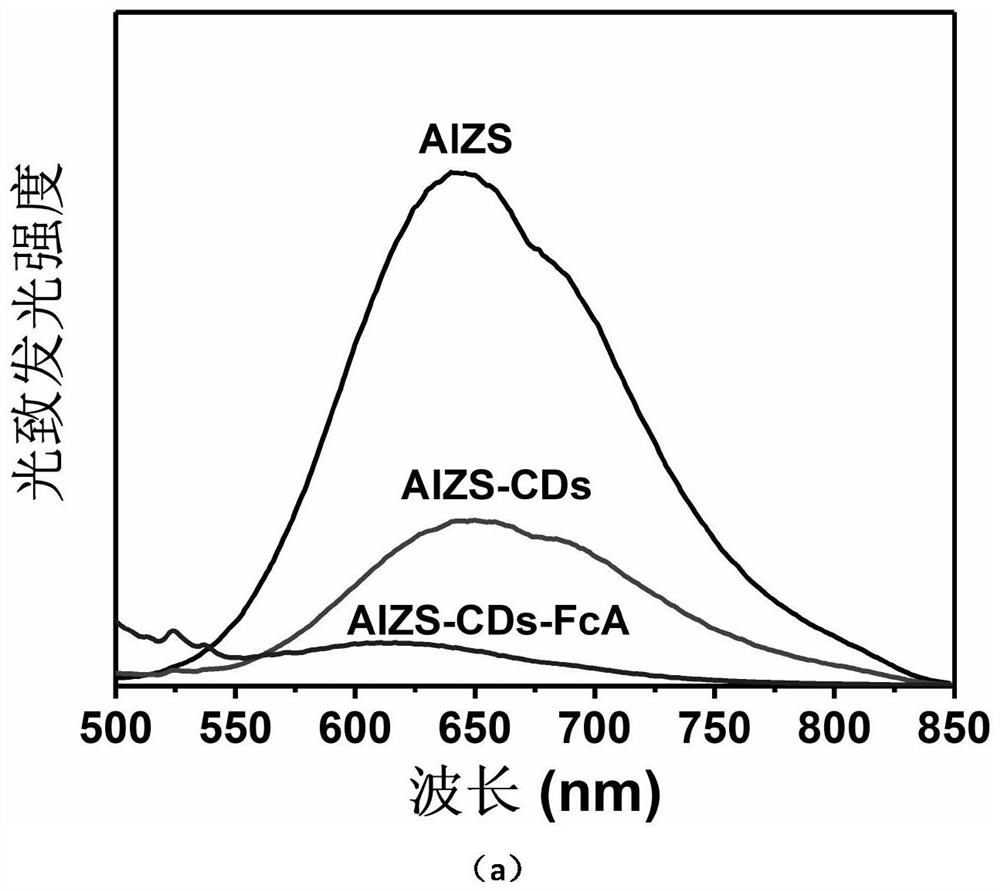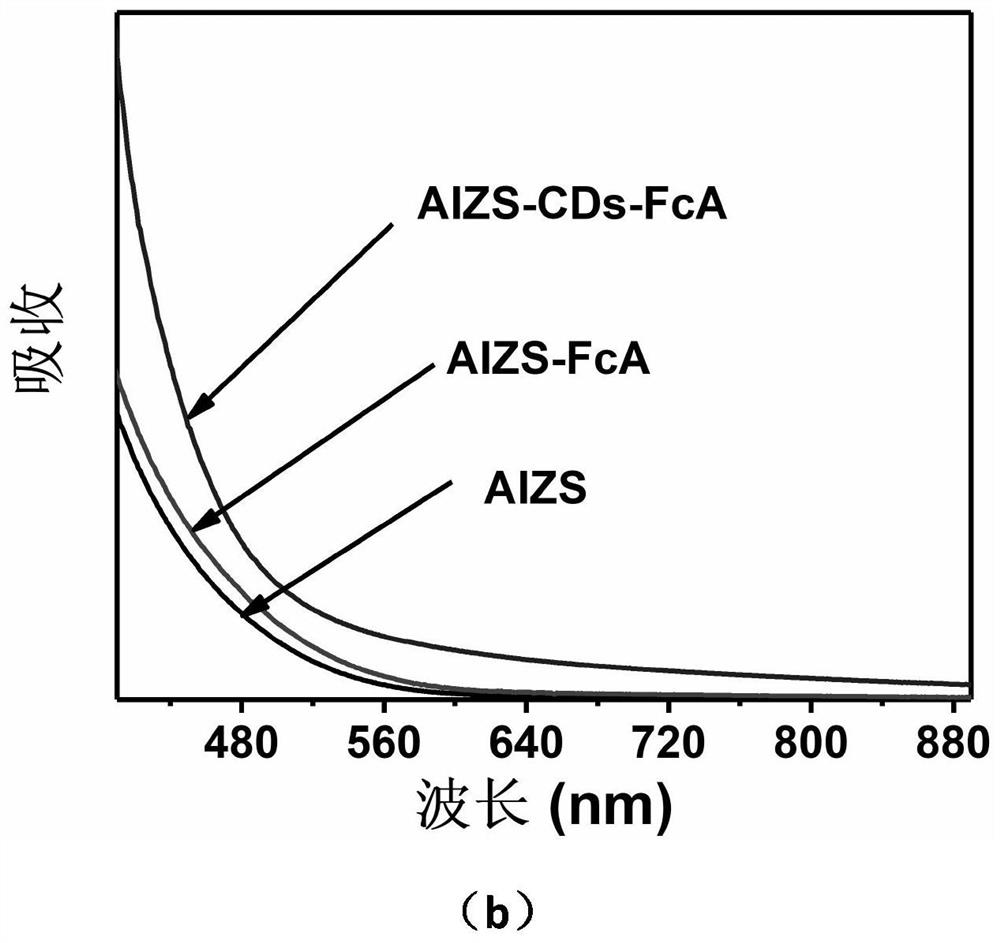Preparation method and application of functional carbon quantum dots modified ag-in-zn-s quantum dots
An ag-in-zn-s, carbon quantum dot technology, applied in chemical instruments and methods, hydrogen production, physical/chemical process catalysts, etc., can solve the problem of lack of clear proof of the role of CDs, and reduce the recombination efficiency. , the process is simple, the effect of high efficiency
- Summary
- Abstract
- Description
- Claims
- Application Information
AI Technical Summary
Problems solved by technology
Method used
Image
Examples
Embodiment 1
[0025] (1) Preparation of CDs-FcA precursor:
[0026] Pipette 12 mg of CDs and 0.48 mg of ferrocene formic acid solution into a transparent glass bottle and dilute to 20 mL of solution, transfer to an autoclave at 140 °C for hydrothermal reaction for 4 h, and use after cooling.
[0027] (2) Preparation of AIZS-CDs-FcA composite photocatalyst:
[0028] Weigh 0.0576g silver nitrate, 0.649g indium nitrate, 0.186g zinc acetate dihydrate, 0.6058g L-cysteine and dissolve them in 50g water, mix the solutions and adjust the pH of the solution to 8.5 with 1M NaOH and add step (1 ) and 0.244 g of thioacetamide were ultrasonically stirred, and hydrothermally reacted in an autoclave at 110° C. for 4 hours. After the reaction, centrifugal washing was performed to obtain an AIZS-CDs-FcA composite photocatalyst.
[0029] Get the sample 0.02g catalyst and 0.528g L-ascorbic acid in (2) and join in the photoreactor, and the large flow rate is passed into N 2 After the gas in the bottle is e...
Embodiment 2
[0031] (1) Preparation of CDs-FcA precursor:
[0032] Pipette 12 mg of CDs and 1.2 mg of ferrocene formic acid solution into a transparent glass bottle and dilute to 20 mL of solution, transfer to an autoclave at 140 °C for hydrothermal reaction for 4 h, and cool for later use.
[0033] (2) Preparation of AIZS-CDs-FcA composite photocatalyst:
[0034] Weigh 0.0576g silver nitrate, 0.649g indium nitrate, 0.186g zinc acetate dihydrate, 0.6058g L-cysteine and dissolve them in 50g water, mix the solutions and adjust the pH of the solution to 8.5 with 1M NaOH and add step (1 ) and 0.244 g of thioacetamide were ultrasonically stirred, and hydrothermally reacted in an autoclave at 110° C. for 4 hours. After the reaction, centrifugal washing was performed to obtain an AIZS-CDs-FcA composite photocatalyst.
[0035] Get the sample 0.02g catalyst and 0.528g L-ascorbic acid in (2) and join in the photoreactor, and the large flow rate is passed into N 2 After the gas in the bottle is e...
Embodiment 3
[0037] (1) Preparation of CDs-FcA precursor:
[0038] Pipette 12 mg of CDs and 1.92 mg of ferrocene formic acid solution into a transparent glass bottle and dilute to 20 mL of solution, transfer to an autoclave at 140 °C for hydrothermal reaction for 4 h, and use after cooling.
[0039] (2) Preparation of AIZS-CDs-FcA composite photocatalyst:
[0040]Weigh 0.0576g silver nitrate, 0.649g indium nitrate, 0.186g zinc acetate dihydrate, 0.6058g L-cysteine and dissolve them in 50g water, mix the solutions and adjust the pH of the solution to 8.5 with 1M NaOH and add step (1 ) and 0.244 g of thioacetamide were ultrasonically stirred, and hydrothermally reacted in an autoclave at 110° C. for 4 hours. After the reaction, centrifugal washing was performed to obtain an AIZS-CDs-FcA composite photocatalyst.
[0041] Get the sample 0.02g catalyst and 0.528g L-ascorbic acid in (2) and join in the photoreactor, and the large flow rate is passed into N 2 After the gas in the bottle is ex...
PUM
 Login to View More
Login to View More Abstract
Description
Claims
Application Information
 Login to View More
Login to View More - R&D
- Intellectual Property
- Life Sciences
- Materials
- Tech Scout
- Unparalleled Data Quality
- Higher Quality Content
- 60% Fewer Hallucinations
Browse by: Latest US Patents, China's latest patents, Technical Efficacy Thesaurus, Application Domain, Technology Topic, Popular Technical Reports.
© 2025 PatSnap. All rights reserved.Legal|Privacy policy|Modern Slavery Act Transparency Statement|Sitemap|About US| Contact US: help@patsnap.com



